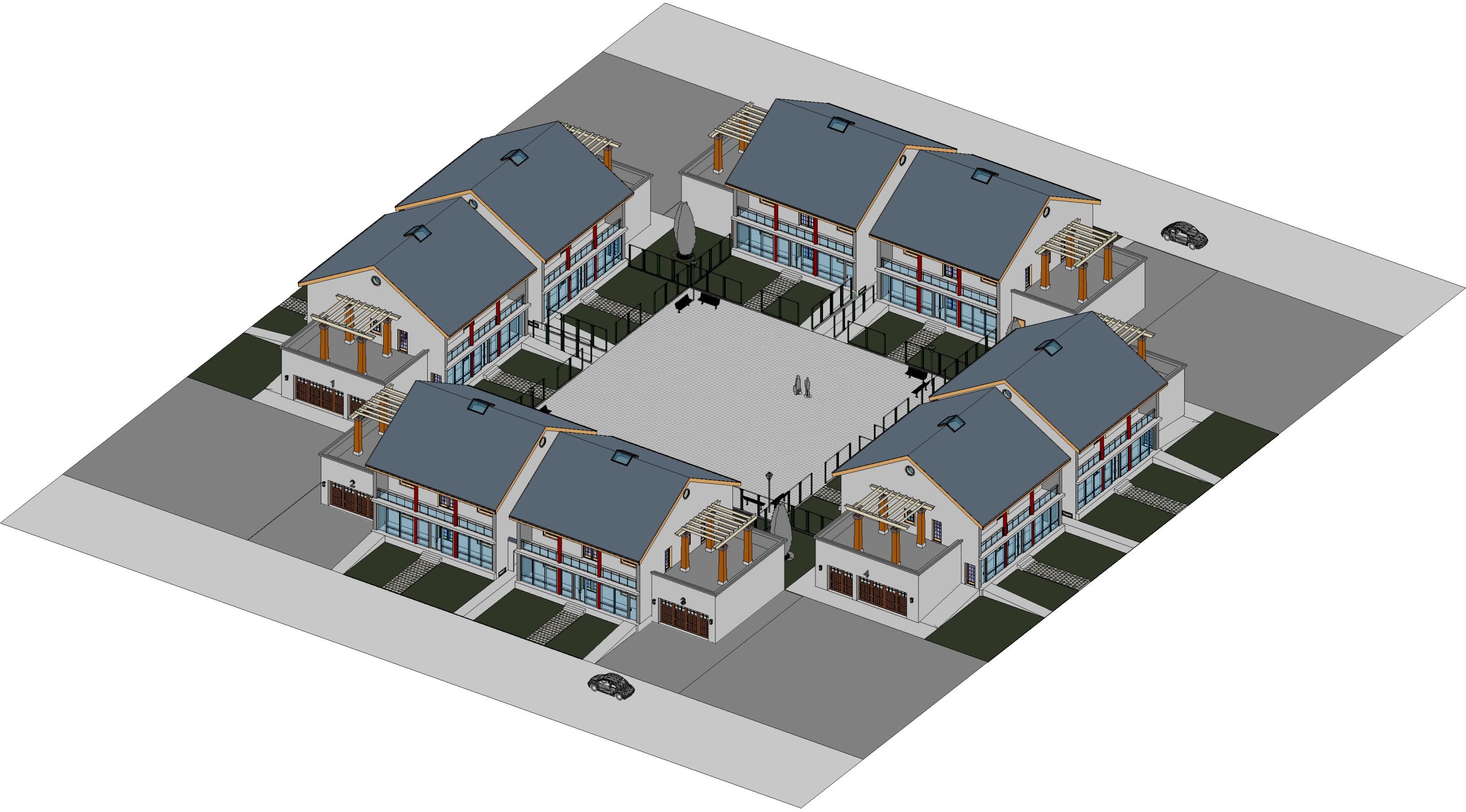39
Donia Zhang, York University, Canada
This paper highlights the key findings from the author’s 2015 book Courtyard Housing for Health and Happiness: Architectural Multiculturalism in North America. The study investigated the interrelations of housing-health-happiness, and examined health from a cultural perspective. It defined a courtyard as a “pedestrian, communal, outdoor space enclosed on three or four sides by buildings or walls, in which residents/tenants can sit, talk, and socialize with one another” (Zhang, 2015, p. 7). Although courtyard housing is an uncommon house type in North America, the number is rising. This article chronicles 100 years (1910s-2010s) of courtyard housing development in the USA and Canada, and argues that sustainable urbanization in North America must apply Architectural Multiculturalism. It further recommends new housing designs incorporating communal courtyards.
History of Courtyard Housing in North America
The courtyard housing development in North America evolved from two cultural roots at the turn of the 20th century. One branch emerged in Toronto, Ontario in the 1910s-1920s, designed in English Tudor style by Canadian architect Eden Smith (1858-1949), who was influenced by the “Garden City” movement initiated in the UK in 1898. The examples are the Bain Apartments Co-operative (former “Riverdale Courts,” b. 1913-1920s) (Austin, 2013), and the Spruce Court Housing Co-operative (b. 1913-1926). The State of Oregon also has a heritage of courtyard housing often built in English cottage style in Portland’s streetcar-served neighborhoods in 1900-1950 (City of Portland, 2008). Another branch appeared in California, USA, adapted from Spanish precedents, and designed and built by American architects Nina and Arthur Zwebell in the 1920s-1930s. It then spread to the city of New Orleans, and some other places in the USA (Hawthorne, 2005; Lasner, 2012; Leigh, 2004; Polyzoides, Sherwood, and Tice, 1982/1992; Reynolds, 2002).
Since the 1960s, courtyard housing revived and was constructed in American cities (Zhang, 2015). It was further resurrected as part of the New Urbanism movement in the 1990s. The outstanding examples are the Harper Court (b. 2002) in West Hollywood, California; the Meridian Court (b. 2004) in Pasadena, California, among others. Most of these projects are in Mediterranean style, designed or restored by American architects Stefanos Polyzoides and Elizabeth Moule, who attempted to reconnect with Los Angeles history and improve the urbanism of the city (Broffman, 2008; Jarmusch, 2004; Kellogg, 2006; Leigh, 2004; McDonald, 2005; Newman, 2002).
To achieve better social integration and cultural vitality, co-operative housing and cohousing started to be built in North America in the 1980s. The author observed that in 2013, 16 of 53 (30%) co-operative housing in Toronto have identified with one or more courtyards. In 2013-2014, the Canadian Cohousing Network (formed in 1992) as part of a global cohousing initiative endorsed 28 cohousing projects across Canada, and courtyard spaces are fundamental to the cohousing design concept. In 2013, the Cohousing Association of the United States listed 213 cohousing communities on their website, and in 2014, the number increased to 234.
Planning for Architectural Multiculturalism
With China’s fast economic development since the 1990s, ethnic Chinese have become the second largest foreign home-buyers in the USA, behind Canadians (California Association of Realtors, 2011; National Association of Realtors, 2012, 2013). This phenomenon prompts North American real estate markets to consider offering homes to meet ethnic Chinese needs for cultural roots and connection.
Since 2012, there have been reports about a large project of “China City of America” in the State of New York, with various culturally-themed parks, a school, a medical center, and 1,000 housing units in both Chinese courtyard and Western villa styles, among other things. The plan is becoming reality in the Sullivan County, NY over multiple years (China City of America, 2014). Similar concepts have been proposed in Michigan and Idaho (Zheng, 2012). This venture has aroused heated debates (Hust, 2013; Mattern, 2013; Vickery, 2012) and pointed to the critical question of multicultural planning and design.
Canada was the first country in the world to establish a national policy of Multiculturalism in 1971, and protects it in the Canadian Multiculturalism Act of 1988. In his article “What is This Thing Called Multicultural Planning?,” Mohammad A. Qadeer (2009) called for policies/projects for ethnic heritage preservation, guidelines for housing to suit diverse groups, and promoting ethnic community initiatives for housing and neighborhood development (p. 13). David Beynon (2009) likewise observed that the way the built environment represents and accommodates people of different cultures is an important aspect of developing a sustainable society; increased understanding and knowledge of the impact of immigration and Multiculturalism on the built environment will facilitate planners and architects to create inclusive and dynamic cities and communities to celebrate.
Ronald G. Knapp’s (2010) Chinese Houses of Southeast Asia is a masterpiece on Architectural Multiculturalism. The book vividly demonstrates that cultural diffusion, interaction, and assimilation have resulted in these hybrid houses combining Chinese, European, as well as indigenous architectural styles and features that are stunningly beautiful.
Designing with Courtyard Space
The author’s previous doctoral research in China shows that a courtyard helps maintaining physical health or natural healing, and facilitates residents’ social interaction and cultural activities (Zhang, 2013). Her postdoctoral study indicates that, although 21 percent (n=314) of the surveyed ethnic Chinese and 11 percent (n=37) of the interviewed ethnic Chinese in North America favored courtyard house/housing, 70 percent (n=37) of the interviewed ethnic Chinese desired a communal courtyard in their immediate residential environment for better social interaction and neighborly communication (Zhang, 2015).
Thus the two studies confirm that a courtyard is conducive to residents’ health and happiness (Zhang, 2013, 2015). Christian Schmid (2014) also argued that common spaces in a city can be as sites of encounter and exchange that would provide social networks connections for a daily life that is open to a variety of possibilities, surprises, and innovations (pp. 73, 75). The impact of courtyard configuration on the urban design of neighborhoods and districts is that it would require zoning changes to legitimize courtyard housing designs in North American cities and towns.

References
Austin, A. (2013). 100 Bain Avenue, Toronto, Canada’s Garden City 1913-2013: the early years. Toronto, ON: Alvyn Austin.
Beynon, D. (2009). Architecture, multiculturalism and cultural sustainability in Australian cities. International Journal of Environmental, Cultural, Economic and Social Sustainability, 5(2), pp. 45-58.
Broffman, W. (2008). Romancing the courtyard. Retrieved March 28, 2013 from: http://www.multihousingpro.com/article.php?AID=313
California Association of Realtors (2011). 2011 Annual housing market survey. CA: California Association of Realtors.
China City of America (2014). China City of America becoming reality in Catskills. Retrieved September 30, 2014 from: http://www.chinacityofamerica.com
City of Portland (2008). Courtyard housing: a catalogue of designs and design principles (Portland Courtyard Housing Design Competition). OR: Strategy Custom Publishing.
Hawthorne, C. (2005). Courts with a new spark: L.A.’s architectural heritage. Los Angeles Times (Home), September 15, 2005. Retrieved August 27, 2013 from: http://articles.latimes.com/2005/sep/15/home/hm-courtyard15
Hust, D (2013). Chinese ‘city.’ Retrieved June 15, 2013 from: http://www.sc-democrat.com/news/2013May/17/news.htm
Jarmusch, A. (2004). Lofts at Laurel Court: West Hollywood, California. Architectural Record, 192(11), pp. 204-207.
Kellogg, C. (2006). Case for courtyards pix: how Moule and Polyzoides fought Southern California. Interior Design, February 1, 2006. Retrieved March 28, 2013 from: http://www.interiordesign.net/article/481093-The_Case_For_Courtyards_pix.php
Knapp, R.G. (2010). Chinese houses of Southeast Asia: the eclectic architecture of sojourners and settlers (photographs by A.C. Ong, foreword by G. Wang). Rutland, VT: Tuttle Publishing.
Lasner, M. (2012). High life: condo living in the suburban century. New Haven, CT: Yale University Press.
Leigh, C. (2004). California dreaming: architects aim to reconcile growth with LA’s past. Features, September 15, 2004. Retrieved March 28, 2013 from: http://www.princeton.edu/~paw/archive_new/PAW04-05/01-0915/features2.html
Mattern, K. (2013). China city in Mamakating: $6 billion project part of a national effort?. Retrieved June 15, 2013 from: http://www.gunkjournal.com/2013/05/30/news/1305300.html
McDonald, M. (2005). Courtyard housing. Clem Labinet’s Period Homes, September 2005. pp. 18-21. Active Interest Media.
National Association of Realtors (2012). Profile of international home buying activity 2012. Retrieved July 26, 2012 from: http://www.realtor.org/reports/profile-of-international-home-buying-activity
National Association of Realtors (2013). 2013 Profile of international home buying activity: purchases of U.S. real estate by international clients for the twelve month period ending March 2013. Retrieved August 11, 2013 from: http://www.realtor.org/reports/profile-of-international-home-buying-activity
Newman, M. (2002). Courtyard housing revival. Architecture Week, July 24, 2002, pp. D1.1-2. Retrieved July 21, 2013 from: http://www.mparchitects.com/site/press/courtyard-housing-revival
Polyzoides, S., Sherwood, R., and Tice, J. (1982/1992). Courtyard housing in Los Angeles: a typological analysis. New York: Princeton Architectural Press.
Qadeer, M.A. (2009). What is this thing called multicultural planning? The Bridge, 2(9), pp. 10-13. Retrieved July 15, 2013 from: http://www.metropolis.net/pdfs/qadeer_extracted_plan_canada_e.pdf
Reynolds, J.S. (2002). Courtyards: aesthetic, social, and thermal delight. New York: John Wiley and Sons.
Schmid, C. (2014). Networks, borders, differences: towards a theory of the urban. In N. Brenner (Ed.), Implosions/explosions: towards a study of planetary urbanization (pp. 67-80). Berlin: Jovis Verlag GmbH.
Vickery, J. (2012). Why is China building mega-cities in the U.S.? Retrieved June 15, 2013 from: http://www.policymic.com/articles/8617/why-is-china-building-mega-cities-in-the-u-s
Zhang, D. (2013). Courtyard housing and cultural sustainability: theory, practice, and product. Farnham: Ashgate.
Zhang, D. (2015). Courtyard housing for health and happiness: architectural multiculturalism in North America. Farnham: Ashgate.
Zheng, H. (2012). China to build cities and economic zones in Michigan and Idaho. Retrieved June 15, 2013 from: http://www.policymic.com/articles/8603/china-to-build-cities-and-economic-zones-in-michigan-and-idaho
Author Biography
Dr Donia Zhang is an associate at the City Institute, York University. She is a graduate of Oxford Brookes University (BArch, MA, PhD) in the UK and Brock University (MEd) in Canada. Her area of expertise is in courtyard housing development in China and North America, China’s heritage preservation policies and practices, cultural sustainability, and architectural multiculturalism. Donia has authored four scholarly books: Courtyard Houses of Beijing: Past, Present, and Future (2009/2010/2011), Schoolyard Gardening as Multinaturalism: Theory, Practice, and Product (2009), Courtyard Housing and Cultural Sustainability: Theory, Practice, and Product (Ashgate, 2013), and Courtyard Housing for Health and Happiness: Architectural Multiculturalism in North America (Ashgate, 2015). Her current research focuses on “Cultural Education for Cultural Sustainability: Chinese School Curriculum in Multicultural West.” She is developing the course: “Introduction to Chinese Culture” to promote harmony, happiness, health, and healing in higher education.
Contact email: doniazhang@gmail.com

